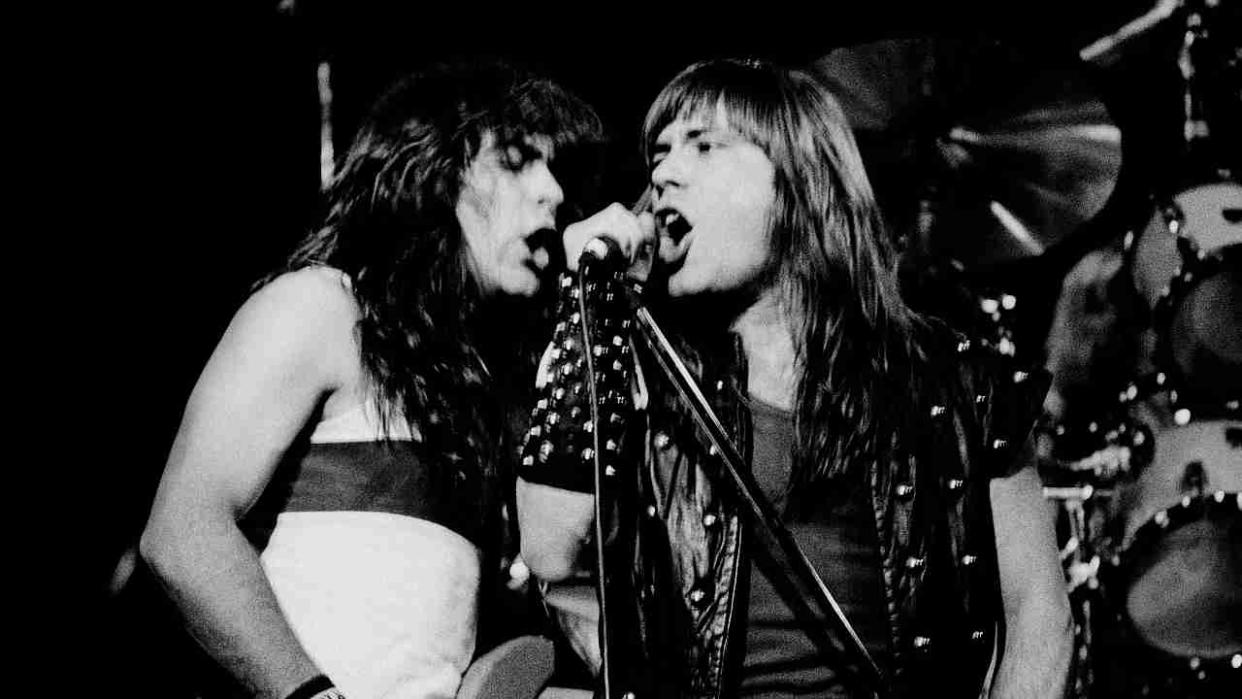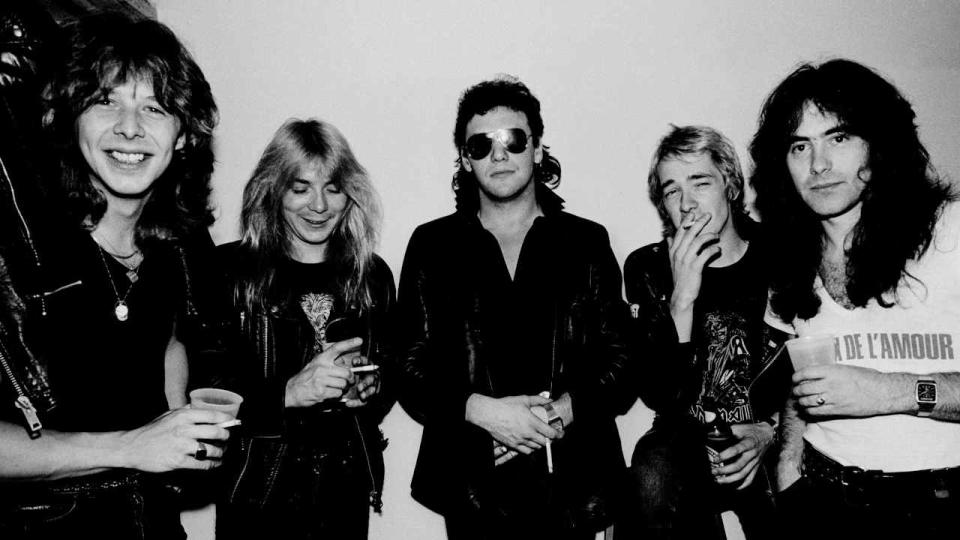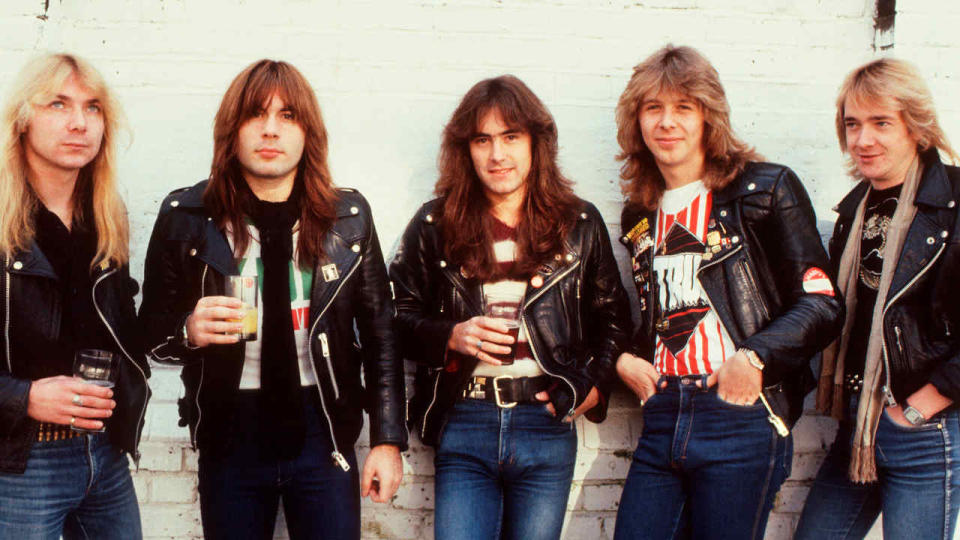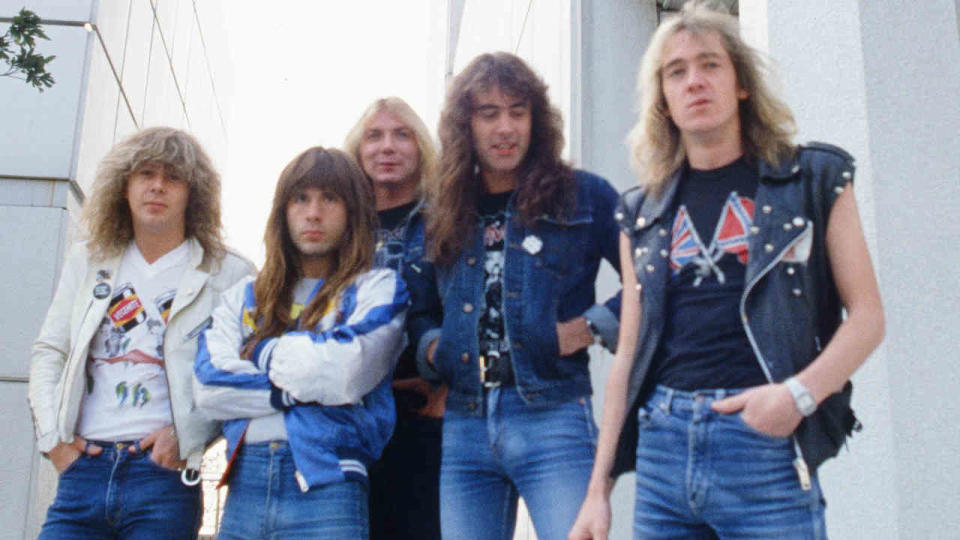“It was like an ego thing. It did make me wonder if Bruce was right for the band”: how Iron Maiden rose above bickering, booze and exhaustion to make The Number Of The Beast, the album that defined them

Iron Maiden may have been at the vanguard of the New Wave Of British Heavy Metal, but they were also one of the first bands from that scene to break out beyond its boundaries. Their self-titled debut album reached No.4 in the UK when it was released in April 1980, setting a bar which their NWOBHM compatriots – Def Leppard and Saxon aside – would struggle to match.
But all was not well within in the band. Follow-up album Killers failed to make the Top 10, and in the summer of 1981, Maiden bassist and founder Steve Harris made the bold decision to fire singer Paul Di’Anno, something which the more dug-in sections of their fanbase weren’t happy with.
But Harris wasn’t a man to roll over and give up. In December 1981, when the freshly minted Kerrang! magazine published its first Readers’ Poll, Maiden were conspicuous by their absence in the Best Band category. The slight didn’t escape Harris’s attention, but he had more pressing matters to focus on. At the time, Maiden were holed up in an East London rehearsal studio with a new singer, 23-year-old Bruce Dickinson, but as yet no new songs for their crucial third album. The pressure was on the young band as never before. But with their backs to the wall, Maiden responded magnificently.
Just four months later they emerged with The Number Of The Beast, a record that not only redefined their own career, but also served as a benchmark for every heavy metal album that has followed over the past 30 years.

Steve Harris: We knew that it was a big deal to change our singer, but we also knew that we couldn’t carry on with Paul. When he first got involved with the band, Rod [Smallwood, manager] asked me was there any potential problems that might crop up in the future that he should know about. And I said: “I’ve got to be honest. There may be a problem with Paul, because sometimes his attitude is a bit weird”.
Paul Di’Anno: By the time of Killers the band was getting a bit more technical. I didn’t think the songs had the same attack, and I started losing interest. I felt that I might be letting people down by voicing my doubts, so I said nothing. But then it built up to the point where I was rubbing Steve up the wrong way.
Steve Harris: I always thought as the band gets more successful maybe he’ll be more into it. But, if anything, the bigger we got, the worse he got.
Rod Smallwood: Paul started to get a bit into the whole ‘lifestyle’ aspect of being a rock star. And I was like, well you better fucking control it, I’m gonna be watching you. I knew the only thing that could fuck up Maiden was themselves. But Paul was so over-the- top. He started having vocal problems, he smoked like a chimney, he drank brandy, now he’s doing a bit of coke and speed too, and he was missing gigs.
Steve Harris: I’m not into drugs myself, never have been. But I’m not against other people doing what they like – as long as it don’t fuck up their gig. Well, Paul was letting it fuck up his gig.
Paul Di’Anno: When you’re fucked up on drugs and alcohol you turn into a complete prick. But I did feel relief when I played that last gig.

Iron Maiden’s final gig with Di’Anno took place at Odd Fellows Mansion in Copenhagen, Denmark on September 10, 1981. Future Metallica drummer Lars Ulrich was among those in the audience to see him take his final bow. But Steve Harris was already searching for a new singer weeks before Di’Anno was shown the door.
Ex-Back Street Crawler frontman Terry Slesser was auditioned behind Di’Anno’s back, but his whisky-soaked rasp didn’t gel with Maiden’s more technical material. Harris turned his attention to the flashy, flamboyantly dressed frontman with Maiden’s NWOBHM peers Samson, Nottinghamshire-born Bruce Dickinson, aka Bruce Bruce.
Bruce Dickinson: Samson only played a few gig with Maiden on the same bill, but I was acutely aware that they had a big following. I checked them out when Samson were headlining above them at a venue called the Music Machine in London [now Koko]. I got goosebumps watching them. It gave me the same feeling I got as a kid listening to Deep Purple In Rock. I remember thinking, “Wow, this is like Purple for the 80s”. I was looking at Paul, thinking I should be up there.
Steve Harris: I’d never been much into Samson, but I’d always thought their singer was good. I thought, “Yeah, the bloke’s got a really good voice, and he knows how to work a crowd”. I thought he sounded a bit like Ian Gillan, actually. When the shit really hit the fan with Paul, he was one of the first people I thought of. Rod wasn’t keen.
Rod Smallwood: I hadn’t even met Bruce, but I didn’t really like him. I thought Bruce Bruce was a stupid name, I thought the white thing he used to wear on stage looked really naff, and also Samson had messed about with Maiden before I got involved; I do bear grudges.
Steve Harris: I didn’t care, I just thought the geezer had a great voice. So I said, “Stuff that, I want him”. And so we arranged to go to Reading to have a look and see if he was interested.
Bruce Dickinson: Rod talked to me at Reading Festival and said he’d like me to try out. The first words out of my mouth were: “Well when I get the job, which I will, don’t expect that it’ll be the same as with the guy you’ve got at the moment”. I thought it was probably best to go in there with all guns blazing.
Bruce Dickinson was officially unveiled as Iron Maiden’s new frontman on stage at the Palasport arena in Bologna, Italy on October 26, 1981. Following a nerve-racking UK debut for the frontman at the Rainbow theatre in London the following month, the band decamped to East London to write their third album. With studio time booked at Battery Studios in North West London in December, the clock was ticking.
Steve Harris: There was a lot of pressure. Not only did we have a new singer, we had no material. The first album was like a ‘best of’ of the songs we’d been playing during the first four years of the band. The second album was mainly early stuff as well, apart from maybe four songs. When we got to the third album we had nothing. We had to write from scratch. Pressure helps to make you come up with the goods. But you have to go through hell to get there.
Adrian Smith [guitarist]: I remember going around to Steve’s place – I think he still lived with his gran at the time – and he was playing me the idea for The Number Of The Beast. I thought: “Wow. That’s amazing. That’s really different”.
Martin Birch [producer]: When Bruce joined, it opened up the possibilities for the new album tremendously. I simply didn’t think Paul was capable of handling vocals on some of the quite complicated directions I knew Steve wanted to explore.
Bruce Dickinson: It was quite good, in that way, because I wasn’t going to be asked to sing words that had already been written by Paul, or songs Steve had written with him in mind. It was all fresh.

Adrian Smith: I was pretty shy about showing the band my songs. It’s painful to sit in front of your bandmates and go: “This is my idea”, and have them just stare at you. But I thought that if I wanted to stay in the band I’d get pretty frustrated if I didn’t contribute ideas. And, fortunately, with The Prisoner Steve liked what he heard.
Bruce Dickinson: The Prisoner started off in the rehearsal room. Our drummer [Clive Burr] wasn’t there, he was out having a cup of tea, so being a frustrated drummer I started bashing out this simple drum beat at the beginning, and then Adrian started playing this riff. Harry came in and went: “Wow, what a great riff!”. And then we just started.
Adrian Smith: And 22 Acacia Avenue was something I came up with when I was very young, one of those first songs you write. I had this band, Urchin, and we did this song, 22. We were getting stuff ready for The Number Of The Beast, and out of the blue Steve turned to me and said: “What was that song you used to do in Urchin?”, and he started humming it. And it was 22. It ended up being on the record.
Bruce Dickinson: I still had a legal sword of Damocles hanging over my head from the Samson contract which meant that I wasn’t allowed to actually write, which was extremely frustrating, but still, the atmosphere was great.
Martin Birch: I had the same feeling on The Number Of The Beast as when we did the Deep Purple album Machine Head [Birch was he engineer on the latter]. It was the same kind of atmosphere, the same kind of feeling, like, something really good is happening here.
Bruce Dickinson: Martin was like a guru to me, and everyone in Maiden at the time. The whole thing was just a lads’ night out. We had a bloody great time.
Martin Birch: I remember we spent ages getting the vocal intro to the title track right. We did it over and over and over until Bruce said: “My head is splitting. Can’t we move on and do something else and come back to this?”. But I wouldn’t let him do anything else until he’d got it perfect. It drove him crazy.
Bruce Dickinson: I got pissed off to the extent that I was trashing the room. When the tape was on, Martin asked me if I could do the scream at the end of the first verse. I was like, “Oh, willingly”.
Steve Harris: The idea was to get a blood-curdling scream like the one on [The Who’s] Won’t Get Fooled Again. It worked quite well.
Martin Birch: On the Sunday we were working on the track The Number Of The Beast, it was a rainy night and I hit this van. I looked in the back of the van and it’s got about half-a-dozen nuns in the back. And then this guy starts praying to me. A couple of days later I took my Range Rover in to be repaired, and when they give me the bill it was 666 pounds.
Steve Harris: People don’t believe this, but he changed it to 667.
Martin Birch: I remember saying to them when it was finished: “This is gonna be a big, big album. This is gonna transform your career”. It just had all the magical ingredients: feel, ideas, energy, execution. And I think the response I got was: “Oh, really?”
The first teaser for Maiden’s third album was the galloping, Wild West-themed single Run To The Hills. Released on February 2, 1982, before work on its parent album was complete, it became Maiden’s first Top 10 single, entering the UK chart at No.7.
Proudly out of step with the rest of their chart peers, Maiden were considered a novelty by the media; appearances on Top Of The Pops and anarchic Saturday morning children’s TV show Tiswas followed, raising the band’s profile considerably. The exposure paid off. Released on March 29, The Number Of The Beast debuted in the UK album chart at No.1.
Steve Harris: Run To The Hills was written in that rehearsal room too. I came up with some riffs and we worked it out there and then. It was very spontaneous. It came out fantastic.
Bruce Dickinson: We were on tour in Winterthur, Switzerland when we got the news about the album. We got a telegram on the Sunday morning going: “Your album is number one!”. And we went: “Fantastic!”. But at the time, we were pushing a 30-seat coach to jump start it, because the driver had let the battery go flat.
Steve Harris: We knew that we’d made a strong album, but sometimes that’s not enough. For it go like that, with Top 10 singles and number one album, was incredible.
The Beast On The Road tour kicked off on February 25, 1982 at Queensway Hall in Dunstable. It ran for 10 months, racking up a total of 182 shows. And it was on the road that the first tensions between no-nonsense bandleader Harris and his cocky, mouthy, public school- educated new singer began to surface.
Bruce Dickinson: Steve and myself always used to clash. He wanted to fire me after the first month of The Number Of The Beast tour.
Rod Smallwood: There was a bit of argy-bargy between them on stage.
Steve Harris: At first I thought I was imagining it. But there were nights on stage during the early part of that tour when Bruce used to, like, try and jostle me on stage. It was all done in fun… only you could tell it was a bit more than that sometimes.
Bruce Dickinson: You had basically a very passive band, except for Steve, who was right up front in the middle. And when I was watching them from the front I was like: “Hmm, I don’t like the look of that, that’s wrong. The singer should be standing there”. So the first thing I did was move my little monitors into the middle, which got in his way. I’d be singing along, getting into the groove, and I’d feel this thump, and he’d be there, elbowing me out of the way.
Steve Harris: It was like an ego thing. And it did make me wonder if he was right for the band. I don’t know if he thought he had to sort of stamp out his territory or whatever, but he didn’t need to.
Bruce Dickinson: We were young and we were all chucked into this huge shit-storm of success and we dealt with it in different ways. To a certain extent you make a Faustian deal when you join a successful band. There is a price that gets exacted upon you, and there’s very little you can do about that except hope to come out the other end of it right-side up.
On May 11, 1982 Maiden took The Beast On The Road to America for more than 100 shows that took them through to October. In the south, the album’s title track sparked protests from religious groups. “They wanted to believe all that rubbish about us being Satanists,” said a bemused Steve Harris. At the end of the five-month US stint, The Number Of The Beast had broken into the Billboard Top 40, and Iron Maiden were the hottest new metal band on the planet.
Bill Barclay [guitar tech]: The schedules were hefty. We did the Coliseum in El Paso [Texas], flew to England and did the Reading Festival, and the next show was in California. It was pretty heavy going.
Bruce Dickinson: We toured in station wagons, driving around hallucinating with tiredness. Rod said we couldn’t afford a bus, until the tour manager was so exhausted one night that he fell asleep on his feet and sleepwalked off the end of the stage. At that point we got a tour bus. Which then became the subject of all manner of shenanigans.
Adrian Smith: We all liked a drink. And we did overindulge. Part of it was adjusting to the whole thing. I went from being in a pub-circuit band to being in a band that could sell out big venues. It did take a bit of getting used to that pressure.
Bruce Dickinson: The experience of that first US tour was like taking a very powerful drug every night. A bunch of 24-year-olds from England let loose in America, pre-Aids, with endless supplies of drink and party material and willing young girls? We weren’t vicars, but at the same time we’re not daft.
Adrian Smith: Was there a period when anyone considered stimulants harder than drink? I don’t think we should go there in a family magazine. It was mainly booze, let’s leave it at that.

Bruce Dickinson: I remember being pissed, crawling on my hands and knees down a hotel corridor in Tokyo, looking for bread rolls from the room service trays because I was so hungry. I caught a glimpse of myself in a mirror looking like a feral critter and I thought: “What a state you’re in. Look at you!”. I thought I’d better sort this out, because I could already see that 10-month world tours were going to be my life for the foreseeable future.
Steve Harris: Is it true that I used to feign sleep on long-haul flights just to avoid talking to Bruce? Ha ha. No, I don’t think so. We’ve probably all feigned sleep to avoid one another at some point, but I don’t recall specifically doing it to him. Are you trying to cause more arguments?
Thirty years after its release, The Number Of The Beast remains Iron Maiden’s most enduring musical statement, and the record that turned them from an exciting young British band into a proper global concern, in turn wrenching the spotlight back from America to the UK.
Rod Smallwood: It was the record for the time. There was a lot of interest in metal worldwide, and this was the album that focused everybody. Before The Number Of The Beast we were part of the New Wave Of British Heavy Metal. After The Number Of The Beast, Maiden was a worldwide major act.
Steve Harris: I didn’t think it was our best album at the time, and I still don’t. There’s a couple of tracks on it which I think are not quite so good. If Total Eclipse had been on the album instead of Gangland it would have been far better. Also, I think Invaders could have been replaced with something a bit better, only we didn’t have anything else to replace it with at the time.
Bruce Dickinson: We knew that the songs were special. But if we’d known it would be acclaimed as one of the greatest albums in rock history we’d probably have cocked the whole thing up.
Published in Classic Rock issue #170
